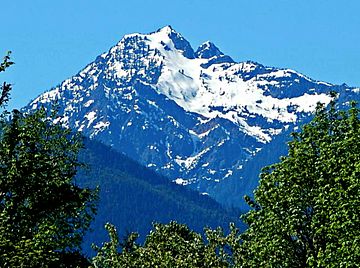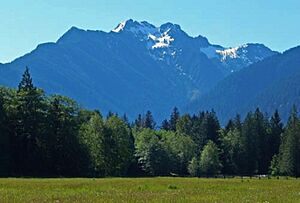Jumbo Mountain facts for kids
Quick facts for kids Jumbo Mountain |
|
|---|---|

Jumbo Mountain seen from the north
|
|
| Highest point | |
| Elevation | 5,840 ft (1,780 m) |
| Prominence | 1,800 ft (550 m) |
| Geography | |
| Parent range | Cascade Range |
| Topo map | USGS Helena Ridge |
| Type of rock | Shale and Sandstone |
| Climbing | |
| Easiest route | Scrambling |
Jumbo Mountain is a tall peak, standing over 5,840 feet high. It's located in Snohomish County, Washington, near the western edge of the North Cascades mountain range. You can find it about four miles south of Darrington, Washington, right along the Mountain Loop Highway. This mountain is part of the Boulder River Wilderness and is managed by the Mount Baker-Snoqualmie National Forest. Miners gave it the name "Jumbo" because it reminded them of an elephant! The closest taller mountain is Buckeye Peak, which is about 3.34 miles (5.38 km) to the west. Water from Jumbo Mountain flows into the Stillaguamish River and Sauk River.
Mountain Weather
Jumbo Mountain is in a "marine west coast" climate zone. This means it gets a lot of weather from the Pacific Ocean. Most weather systems travel from the Pacific Ocean towards the Cascade Range. When these systems reach the North Cascades, the mountains force the air to rise. As the air rises, it cools and drops its moisture as rain or snow. This is called Orographic lift.
Because of this, the western side of the North Cascades gets a lot of rain and snow. This is especially true during the winter months. Since the climate is mild and close to the ocean, temperatures rarely go below 0°F (-18°C) or above 80°F (27°C). In winter, it's often cloudy. But in summer, high pressure systems over the Pacific Ocean often bring clear skies. The snow here tends to be wet and heavy, which can lead to a high risk of avalanches.
How the Mountains Formed
The North Cascades have very rugged land with sharp peaks, ridges, and deep valleys carved by glaciers. The way the land looks today was shaped by huge geological events that happened millions of years ago. These events created the big changes in height and the different climates you see across the Cascade Range. These climate differences also lead to many different types of plants and animals.
The Cascade Mountains started forming millions of years ago, during the late Eocene Epoch. This happened because the North American Plate was slowly moving over the Pacific Plate. This movement caused many volcanic eruptions. Also, small pieces of the Earth's crust, called terranes, came together to form the North Cascades about 50 million years ago.
During the Pleistocene period, which was over two million years ago, glaciers moved across the land many times. As they moved, they scraped away rock and left behind debris. The "U"-shaped valleys you see in the rivers were formed by these glaciers. The lifting up of the land (called uplift) and cracks in the Earth's crust (called faulting), along with the glaciers, have created the tall peaks and deep valleys of the North Cascades area.
- Jumbo Mountain weather forecast: Mountain Forecast




